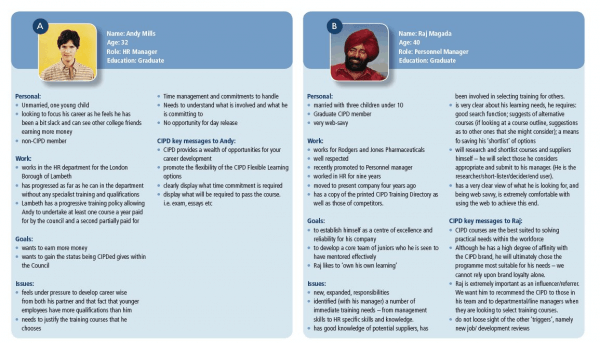An introduction to best practices for using buyer web personas to create more customer-centric websites
Creating personas of website visitors is a powerful technique for helping increase the usability and customer-centricity of a website as part of a user-centered design (UCD) process. I've been a big fan of using personas since around 2003 I was introduced to it by Matt Dooley, a customer experience manager in the HSBC Global E-business team. At the time, they were following reports by Forrester on creating web personas.
This shows that they're certainly not new, indeed their equivalent of using customer thumbnails for customer segmentation or ad campaigns has existed for decades. However, I find they're still not so widely used when giving examples on training courses.
What is a web persona?
A simple definition of a web persona is: "a summary of the characteristics, needs, motivations, and environment of a key type of website user".
A more specific definition originally from the Foviance/Seren guide to segmented personas is:
“A persona is a fictional character that communicates the primary characteristics of a group of users, identified and selected as a key target through use of segmentation data, across the company in a usable and effective manner.
This ultimately enables the company to design the best user experience for its customers at all touchpoints, which is a key success factor in today’s business environment”.
This download for premium Smart Insights Members is aimed at helping businesses, agencies and consultants improve their use of design personas and also to enable companies to specify their business requirements from personas when using internal or external resources.
Download resources – Customer Persona guide and template
Includes many recent examples of Personas, Customer Journey Maps for B2C and B2B audiences and defines best practice techniques to help you define better customer personas.
Access the Customer persona guide and template
Example web personas
At their simplest, customer personas are essentially a ‘thumbnail’ description of a type of person. Here are two simple examples for a music publisher selling music clips and sheet music to a business audience.
- Persona 1 – George: George is a 60-year-old violin teacher who regularly accesses the internet from his personal desktop over a broadband connection. He has never purchased online before, preferring to place orders by phone.
- Persona 2 – Georgina: Georgina is a 29-year-old ad exec who is connected to the internet all day. She confidently uses her Macbook, iPad, and Android phone to access the web - whatever is to hand.
You can see that these are quite different types of people who will have quite different needs. Some companies simply use personas at this level. True design personas have a more detailed narrative and summary of customer goals and characteristics as some of the examples later in this post show.
The best way to understand the power of web design personas is with examples. Here are two classic examples I used in training when personas first started being used for creating more customer-centered web designs. Our bite-sized Learning Path module on personas is a great place to start.
Core Module

Define audience personas
Part of the Content marketing Toolkit
Learn how to develop a customer persona that can help you to target your marketing more effectively
Learn MoreB2B web persona example
Within Business-to-business marketing, customer personas are often known as buyer personas.
This example is brief but illustrates the main type of characteristics that should be thought with a B2B persona including:
- Personal characteristics
- Company role
- Work and career goals
- Work challenges
- Tasks
- Key messages

You can see that the definition of the persona includes both business and personal issues and goals along with key messages or services relevant for this persona. Typical of B2B personas the 8 personas developed in this example encompass a range of company sizes, personas, and responsibilities within the buying unit.
Combining personas with customer scenarios or customer journeys
Customer scenarios (customer journeys) can and should be developed for different personas.
Not creating customer journey or content maps is a mistake I have seen in many businesses, these are essential to getting the most out of personas to operationalise them since they look at specific information needs, search terms used and how content formats and types available on the site will answer these questions.
Patricia Seybold in her book: The Customer Revolution, explains them as follows:
A customer scenario is a set of tasks that a particular customer wants or needs to do in order to accomplish his or her desired outcome.
You can see that scenarios can be developed for each persona. For an online bank, scenarios might include:
- New customer – opening an online account
- Existing customer – transferring an account online
- Existing customer – finding an additional product
Each scenario is split up into a series of steps or tasks before the scenario is completed. These steps can be best thought of as a series of questions a visitor asks. These questions identify the different information needs of different customer types at different stages in the buying process.
The use of scenarios is a simple, but very powerful web design technique that is still relatively rare in website design. Evidence of the use of scenarios and persons in sites is when the needs of a range of audiences are accommodated with navigation, links, and search to answer specific questions. Clear steps in a booking process are also an indication of the use of this approach.
The approach has the benefits of:
- Fostering customer centricity;
- Identifies detailed information needs and steps required by customers;
- Can be used to both test existing website designs or prototypes and to devise new designs
- Can be used to compare and test the strength and clarity of communication of proposition on different websites.
- Can be linked to specific marketing outcomes required by site owners.
Guidelines on developing web design personas
Finally, I have some top-level guidelines and ideas on what can be included when developing a persona. Start or end with giving your persona a name. The detailed stages are:
1. Build personal attributes into personas:
- Demographic: Age, gender, education, occupation, and for B2B, company size, position in buying unit.
- Psychographic: Goals, tasks, motivation
- Webographics: Web experience (months), usage location (home or work), usage platform (desktop, tablet, mobile), usage frequency, social media sites, favorite sites in and out of category.
2. Remember that personas are only models of characteristics and environment:
- Design targets
- Stereo-types
- 3 or 4 usually suffice to improve general usability, but more needed for specific behaviors
- Choose one primary persona who, if satisfied, means others are likely to be satisfied
3. Different scenarios or customer journeys can be developed for each persona as explained further below:
- Write 3 or 4, for example: Information seeking scenario (leads to site registration), Purchase scenario – new customer (leads to sale), Purchase scenario – existing customer (leads to sale).
Once different personas have been developed who are representative of key site visitor types or customer types, a primary persona is sometimes identified. Wodtke (2002) says:
“Your primary persona needs to be a common user type who is both important to the business success of the product and needy from a design point of view – in other words, a beginner user or a technologically challenged one”.
She also says that secondary personas can also be developed such as super-users or complete novices. Complementary personas are those that don’t fit into the main categories or display unusual behavior. Such complementary personas help ‘out-of-box thinking’ and offer choices or content that may appeal to all users.
Need a plan to create a winning marketing strategy?
Get started today using a tried and tested step-by-step process to optimize your marketing.
Start Now
Guidelines on applying web design personas
Thanks to our expert commentator, Richard Sedley of Seren for contributing these.
- Get sign-off from all key stakeholders in business that these are accurate representations of their audience because if they disagree the personas won’t get used (which is what usually happens).
- How personas are presented is also essential: Create pocket cards of people in projects to carry around, place at the front of reports and documents to show who your target audiences are, create life-size cut outs. One of our clients is even proposing using actors for a day so that staff and team members can ‘meet their personas’
- Personas are used to help those in teams that might never meet the customer. The development team uses them to ensure that as specs change (which they do) in a project life-cycle you don’t lose sight of who you are designing and building for.
Please share your thoughts or experiences with personas, including negative ones!
Download resources – Customer Persona guide and template
Includes many recent examples of Personas, Customer Journey Maps for B2C and B2B audiences and defines best practice techniques to help you define better customer personas.
Access the Customer persona guide and template











